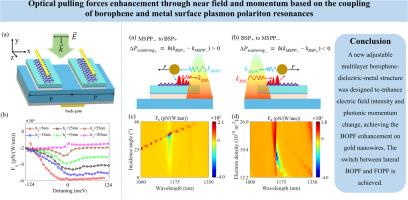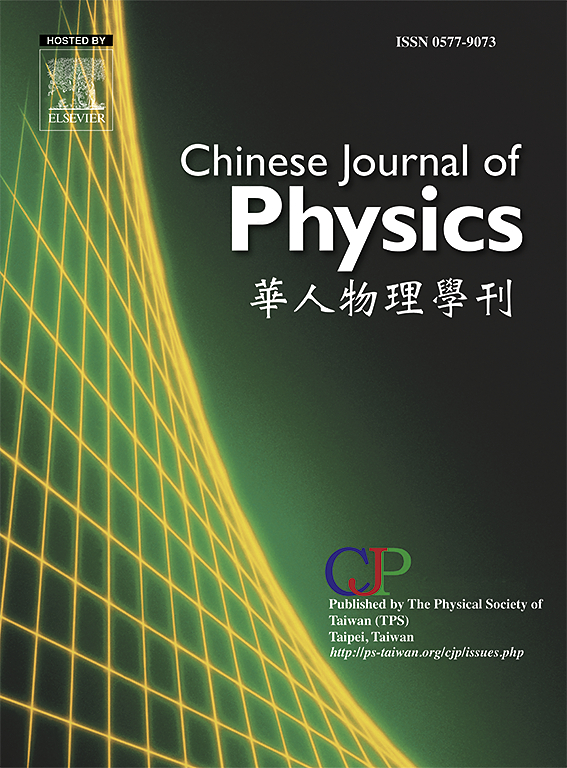基于硼罗芬和金属表面等离子激元极化共振耦合的近场和动量光拉力增强
IF 4.6
2区 物理与天体物理
Q1 PHYSICS, MULTIDISCIPLINARY
引用次数: 0
摘要
与前向光推力(FOPF)相比,后向光拉力(BOPF)由于光学操作的灵活性而受到广泛关注。设计了一种硼苯-介电-金属多层结构,增强了电场强度和光子动量变化,实现了金纳米线上的BOPF增强。在结构中,硼苯等离子激元的激发是提高等离子激元偏振场的关键。BSP与腔共振模式之间的强耦合增强了电强度。耦合模共振产生辐射,产生纵向力Fy。当斜入射光激发bsp时,产生横向动量,产生横向BOPF Fx。强耦合共振增强了纵向力Fy和横向力Fx。此外,该结构中的周期光栅还能激发金属表面等离子激元(MSPPs)。当负MSPP模式与BSP模式重合时,通过金纳米线的散射产生两者之间的耦合,从而产生较大的光子动量增量(BSP和MSPP的动量之和,∑kBSP+∑kMSPP)。基于动量守恒,横向BOPF得到了极大的增强。横向FOPF和BOPF的切换是通过MSPP和BSP之间的交换来实现的。BOPF增强在光-物质相互作用技术中有重要的应用,如信号处理、粒子捕获和光镊。本文章由计算机程序翻译,如有差异,请以英文原文为准。

Optical pulling forces enhancement through near field and momentum based on the coupling of borophene and metal surface plasmon polariton resonances
Backward optical pulling force (BOPF) has gained much attention due to flexible optical manipulation compared to forward optical pushing force (FOPF). A multilayer borophene-dielectric-metal structure was designed to enhance electric field intensity and photonic momentum change, achieving the BOPF enhancement on gold nanowires. In the structure, the excitation of borophene plasmon polaritons (BSPs) is a key to improving BOPF. The electric intensity is enhanced by the strong coupling between BSP and cavity resonance modes. The resonances of coupled modes generate radiation, resulting in a longitudinal force . When the BSPs were excited by oblique incidence light, lateral momentum was generated, resulting in a lateral BOPF . Both the longitudinal force and lateral force were enhanced by the strong coupling resonances. Moreover, metal surface plasmon polaritons (MSPPs) were excited by the periodic grating in the structure. When the negative MSPP mode coincides with the BSP modes, the coupling between them is generated through the scattering of the gold nanowire, resulting in a large photonic momentum increment (the sum of the momenta of BSP and MSPP, ). Based on the conservation of momentum, the lateral BOPF was enhanced extremely. The switching between lateral FOPF and BOPF is achieved by the exchange between MSPP and BSP. The BOPF enhancement has important applications in light-matter interaction techniques, such as signal processing, particle trapping, and optical tweezers.
求助全文
通过发布文献求助,成功后即可免费获取论文全文。
去求助
来源期刊

Chinese Journal of Physics
物理-物理:综合
CiteScore
8.50
自引率
10.00%
发文量
361
审稿时长
44 days
期刊介绍:
The Chinese Journal of Physics publishes important advances in various branches in physics, including statistical and biophysical physics, condensed matter physics, atomic/molecular physics, optics, particle physics and nuclear physics.
The editors welcome manuscripts on:
-General Physics: Statistical and Quantum Mechanics, etc.-
Gravitation and Astrophysics-
Elementary Particles and Fields-
Nuclear Physics-
Atomic, Molecular, and Optical Physics-
Quantum Information and Quantum Computation-
Fluid Dynamics, Nonlinear Dynamics, Chaos, and Complex Networks-
Plasma and Beam Physics-
Condensed Matter: Structure, etc.-
Condensed Matter: Electronic Properties, etc.-
Polymer, Soft Matter, Biological, and Interdisciplinary Physics.
CJP publishes regular research papers, feature articles and review papers.
 求助内容:
求助内容: 应助结果提醒方式:
应助结果提醒方式:


